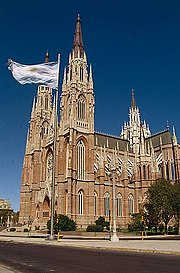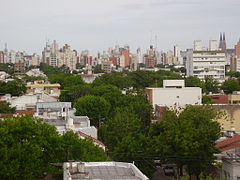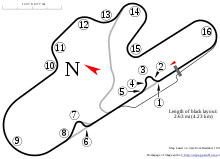La Plata
La Plata | |
|---|---|
| Ciudad de La Plata | |
 | |
| Country | |
| Founded | 1982 |
| Government | |
| • Intendant | Pablo Bruera |
| Area | |
| • City | 203 km2 (78.5 sq mi) |
| • Land | 203 km2 (78.5 sq mi) |
| • Metro | 4,758 km2 (1,837 sq mi) |
| Elevation | 26 m (85 ft) |
| Population | |
| • City | 563.943 |
| • Metro | 694.253 |
| Demonym | platense |
| Time zone | UTC-3 (ART) |
| Area code | +54 221 |
La Plata (English: Silver) is the capital city of the province of Buenos Aires, Argentina, as well as of the partido of La Plata. The city was planned to serve as the capital of the province after the city of Buenos Aires was declared as the federal district in 1880. Per the 2001 census [INDEC], the city proper has a population of 574,369 and its metropolitan area has 694,253 inhabitants.
La Plata was officially founded by Governor Dardo Rocha on November 19, 1882 and its construction was fully documented in photographs by Tomás Bradley Sutton.[1] It was referred to as Eva Perón City (Ciudad Eva Perón) between 1952 and 1955.
History and description


Rocha decided to erect a new city to host the provincial government institutions and the planned university. Urban planner Pedro Benoit designed a city layout based on a rationalist conception of urban centers. The city has the shape of a square with a central park and two main diagonal avenues, north-south and east-west. (In addition, there are numerous other shorter diagonals.) This design is copied in a self-similar manner in small blocks of six by six blocks in length. Every six blocks, one finds a small park or square. Other than the diagonals, all streets are on a rectangular grid, and are numbered consecutively. Thus, La Plata is nicknamed "la ciudad de las diagonales" ("city of diagonals"). It is also called "la ciudad de los tilos" ("city of tilia (linden tree)") because of the large number of linden trees lining many streets and squares.
The city design and its buildings are said to possess a strong Freemason symbolism. This is said to be a consequence of both Rocha and Benoit being Freemasons.
The designs for the government buildings were chosen in an international architectural competition. Thus, the Governor Palace was designed by Italians, City Hall by Germans, etc. Electric street lighting was installed in 1884, and was the first of its kind in Latin America.

The cathedral of La Plata, in neo-Gothic style, is the largest church in Argentina.
The Curutchet House is one of the two buildings by Le Corbusier in the Americas. The Teatro Argentino de La Plata is the second most-important opera house in Argentina after the Teatro Colón in Buenos Aires.
The University of La Plata was founded in 1897 and nationalized in 1905. It is well-known for its observatory and natural history museum. Ernesto Sabato graduated in physics at this university; he went on to teach at the Sorbonne and the MIT before becoming a famed novelist. Doctor René Favaloro was another famous alumnus. During its early years, it attracted a number of renowned intellectuals from the Spanish-speaking world, such as Dominican Pedro Henríquez Ureña.
Under Alvear's administration (1922–1928), Enrique Mosconi, the president of the oil state company Yacimientos Petrolíferos Fiscales, created the distillery of La Plata, which was the tenth largest in the world.[2]

The city was renamed in 1952 as Eva Perón, though the original name was restored in 1955. La Plata's residents are served by numerous daily newspapers, the most prominent of which is El Día.
The city is home to two football (soccer) teams that play in the first division: Estudiantes de La Plata and Gimnasia y Esgrima La Plata.
Geography
Location
Located in the northeastern province of Buenos Aires, limiting to the northeast with Ensenada and Berisso, northwest with the Berazategui and Florencio Varela, southwest and south, with San Vicente and Coronel Brandsen and southeast with Magdalena, occupying an area of 893 km.
The metropolitan area of La Plata includes besides the founding of the town, the towns of Tolosa, Ringuelet, Manuel B. Gonnet, City Bell, Villa Elisa, Melchor Romero, Abasto, Gorina, José Hernández, Ángel Etcheverry, Arturo Seguí Los Hornos, Lisandro Olmos, Villa Elvira and, Altos de San Lorenzo, all of them with community centers that operate as local delegations.
Time Zone
Climate
Usually warm and humid in the summer. Mild winters.
Average temperature: 16.7°C
Average clear days: 126 Rain: 1023 Mn
Average humidity: 78%
Education
La Plata hosts one of the most renowned universities in Argentina, the National University of La Plata (Spanish: Universidad Nacional de La Plata, UNLP). It has over 75,000 regular students, 8,000 teaching staff, 16 faculties and 106 available degrees.
Famous UNLP students and professors include:
- Raúl Alfonsín (Law degree in 1950) President of Argentina (1983–1989)
- Nestor Kirchner (Law degree) President of Argentina (2003–2007)
- Cristina Fernández de Kirchner (Law degree) President of Argentina (2007-until now)
- René Favaloro (Medicine degree in 1949, creator of the technique for coronary bypass surgery)
- Carlos Saavedra Lamas (law teacher, and rector, Nobel Peace Prize recipient)
- Ernesto Sábato (Physics PhD in 1937)
- Mario Bunge (Physics-Mathematics PhD in 1952)
- Florentino Ameghino (professor of geology)
- Juan José Arévalo (Philosophy PhD in 1934, 24th President of Guatemala)
- Emilio Pettoruti
Four high school institutes are under UNLP control, three of them are located in La Plata:
- Rafael Hernández National High School (Spanish: Colegio Nacional Rafael Hernández)
- Víctor Mercante Lyceum (Spanish: Liceo Víctor Mercante)
- Fine Arts High School (Spanish: Bachillerato de Bellas Artes)
La Plata is also home of other three universities:
- Universidad Católica de La Plata
- Universidad Notarial Argentina
- Facultad Regional de la Universidad Tecnológica Nacional.
Students come to these four universities from every part of Argentina and other countries, giving the city a rich young multicultural lifestyle.
Sports

The most popular sport in the city, as in the whole country, is football. Among the many clubs that play football in the city, two of them stand out above the rest and these are the clubs Estudiantes de La Plata and Gimnasia y Esgrima La Plata, they both play in the First Division of Argentine football. From these two teams came out great players like Martín Palermo, Francisco Varallo, Juan Sebastián Verón and his father, Gustavo and Guillermo Barros Schelotto, Leandro Cufré, among others.
The city also has the Liga Amateur Platense de fútbol that encompasses dozens of clubs in the region, such as: Club Atlético Estrella de Berisso, La Plata Fútbol Club, Asociación Nueva Alianza, Club Everton, among others.
Basketball has a place in the Torneo Nacional de Ascenso (National Tournament Ascent), through Gimnasia y Esgrima La Plata . In addition, through the Asociación Platense de Basquetbol, the city has leagues and tournaments for all levels and categories (First, Second Ascent, U20, Junior, Cadet and Kids Pre-Kids), which involved Clubs: Gimnasia y Esgrima La Plata, Estudiantes, Club Atenas, Unión Vecinal, Centro de Fomento Meridiano V, Club Cultural y Deportivo Juventud, among others.

Auto racing also has its importance in the city from the hands of the Turismo Carretera. For this competition is a racetrack called Autódromo Roberto José Mouras in honor of the historic Chevrolet driver died in Lobos in 1992.[3] Other information relating to motorsport in the city has to do with the last Argentine Formula 1 pilot, who was the "platense" Gastón Mazzacane that after 21 races in Formula 1 came to compete in the Champ Car and Top Race V6.
Rugby, meanwhile, is a comprehensive discipline of fans in the city. The most representative clubs are: La Plata Rugby Club, Club San Luis, Los Tilos, Universitario and Albatros.
Of note is the traditional seat of turf in the city. La Plata has a race track, the third in order of competition and offer careers in the country.
Volleyball teams include Gimnasia y Esgrima and Universitario.
Hockey also claims two teams, Universitario and Santa Bárbara.
Culture
The culture has a major role in the city of La Plata. This is reflected in the large amount of cultural centers, theaters, museums, cinemas and libraries that are in the city, as well as the Universidad Nacional de La Plata and the observatory.



|
Cultural centers
Theaters
Museums
|
|
Cinemas
Libraries
|
Festivals, celebrations and events scheduled

The city of La Plata has the particularity of being the only place (with Berisso and Ensenada) in the country where the burning of Momos (Dolls similar to those cremated at the Fallas festival in Valencia, Spain) is held every New Year's Eve. Hundreds of dolls are burnt to celebrate the end of the year and the beginning of a new year. Competitions for the best doll is awarded by the La Plata municipality and media.[4][5]
In addition, every year on November 19, the anniversary of the city is held with recitals and a fireworks show at the Plaza Moreno.
In La Plata, as well as in all of Argentina, the first day of spring is celebrated along with National Student's Day on September 21. On this date, the municipality organizes concerts both in the Paseo del Bosque and Plaza Moreno.
People
Sister cities
 Kamëz, Albania
Kamëz, Albania Porto Alegre, Brazil
Porto Alegre, Brazil Beersheba, Israel
Beersheba, Israel Anghiari, Italy
Anghiari, Italy Louisville, United States
Louisville, United States Montevideo, Uruguay
Montevideo, Uruguay Liverpool, UK
Liverpool, UK
References
- ^ Thomas Bradley: The photographer of Dardo Rocha (in Spanish)
- ^ Felipe Pigna, Los Mitos de la historia argentina, 3, ed. Planeta Historia y Sociedad 2006, p.153
- ^ "Circuito de La Plata". ACTC. Retrieved 2009-03-17.
- ^ "Recorrida por los tradicionales muñecos de Fin de Año". El Día. 2007. Retrieved 2009-03-17.
- ^ "Finalizó el concurso: el domingo se conocerán los cinco ganadores". El Día. 2008. Retrieved 2009-03-17.
External links
- Template:Es icon Official government website
- Template:Es icon http://www.mapa.laplata.gov.ar Interactive Map of La Plata
- Template:Es icon Municipal information: Municipal Affairs Federal Institute (IFAM), Municipal Affairs Secretariat, Ministry of Interior, Argentina. (in Spanish)

